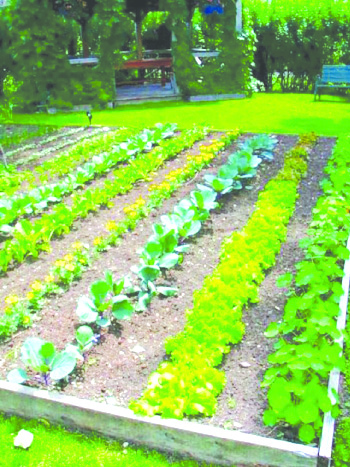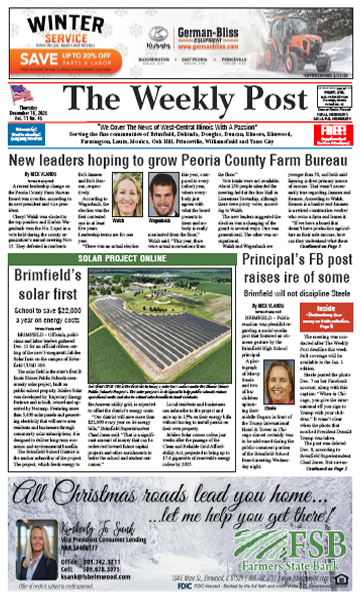
Garden shop sales are booming
By Jeff Lampe
David Christie was unsure what to expect when he opened his Yates City Greenhouse this spring, given the ongoing impacts of COVID-19. He was pretty sure one aspect of his business would be the same, though.
“One of the nicest things about being in this business is that when people come to buy flowers, they’re generally in a good mood,” Christie said. “It’s kind of a good thing to sell.”
This year, with restrictions keeping many businesses closed and many people at home, it has been a very good thing to sell flowers and vegetables.
Christie estimates that his business this spring has been twice as good as normal.
Plant sales have also been strong in Princeville, where the school’s FFA chapter took 450 pre-orders for its annual sale.
“I think all the local seasonal businesses are doing well. People are working on their yards more than ever. They’re doing home projects and it seems like maybe they’re trying to stay closer to home to buy things instead of going to Peoria,” Christie said.
While all plants have sold well, Christie said vegetable sales are particularly strong. On Tuesday, he was almost out of tomatoes and his green peppers were all gone.
“Definitely vegetable gardening is more popular this year with people more worried about the food supply,” he said.
Always wanted a garden? Now is the time

By Ron Dieter
If you’ve been perennially pondering the possibility of planting a vegetable garden but never had the time, what’s your excuse now? Since we’re all supposed to stay home, now is the perfect time to get outside and do some gardening.
If you’re a first-time gardener, start small. A small garden well-tended will yield more food and less frustration than a large garden that gets out of hand. In a plot 10 feet square, you can grow four or five tomato plants, a half-dozen pepper plants, four broccoli plants, a row of green beans, and a couple rows of kale, lettuce and onions.
These are easy vegetables to grow and manage, but grow what you like to eat.
Ideally broccoli and lettuces would be planted already, but you’ll still have good luck if you get it done now. Sow lettuce and kale seeds directly in the garden, however broccoli is easiest to grow when you set out plants rather than seed. I like Packman broccoli because it continues to produce side-shoots after the main head is harvested.
Watch out for the little white butterflies. They want to lay eggs on the leaves of your broccoli plants. Those tiny eggs will hatch into little green worms that will destroy your plants if left untreated.
When the butterflies start scoping out your broccoli plants, apply Bt (Bacillus thuringiensis.) It’s an organic product available as a dust or spray.
Tomatoes are one of the easiest vegetables to grow. My favorite tomato is Big Beef, a large meaty variety with great flavor. A slice fits perfectly atop a juicy hamburger hot off the grill. I also plant Better Boy, Jet Star and Celebrity.
My tomato plants are usually more than a foot tall when I set them out. Tomato plants readily root out along the stem so I plant them deep with just the top three or four inches above the soil line. The idea is to have a large root system deep in the ground where soil stays moist.
The only way you can plant a tomato too deep is if you can’t find it when you’re done.
Even if you don’t do any gardening, you should have one cherry tomato plant. One is all you need because cherry tomato plants are unbelievably prolific. Just one plant, such as Supersweet 100 or Sungold, will yield plenty of bite-size tomatoes for a family of four all summer long. Supersweet 100 is the most prolific of the two, but Sungold is sweeter, in my humble opinion.
I grow one plant each of Sungold and Supersweet 100. I plant them in sixteen-inch patio pots filled with potting soil and a dose of slow-release fertilizer. These plants drink a lot of water so I place a saucer under the pots. It seems to me that tomatoes grown in potting soil are sweeter than those planted out in the garden.
Whether you grow them in a pot or in the garden, cherry tomato plants need to be caged. And the taller the cage the better. These plants can easily be 10 feet tall by the end of the season.
Growing cherry tomatoes is a fun project for kids. They can take part in the planting and they love to pick the little tomatoes and eat them on the spot.
As for peppers, the hardest part of growing them is deciding which varieties to plant. There are hundreds to choose from in a wide array of colors and sizes. Mild or hot – it’s your choice.
Keep in mind that pepper plants are very sensitive to cold. Night temperatures below 50 degrees often causes them to drop their first blossoms.
Don’t set pepper plants out until the end of May.
As pepper plants mature in size, they can be brittle and the branches can easily break, especially on windy days. Give them some extra support using tomato cages or stakes. You can buy a 50 foot roll of Velcro garden ties for about $5. It’s real handy for tying plants to stakes and trellises.
Plan ahead for key times to water vegetables
By University of Illinois Extension
URBANA – This spring has been mild, with occasional rain, but summer heat approaches, so University of Illinois Extension reminds gardeners to think about watering.
All plants need water to survive. Some plants can tolerate dry conditions, but gardeners should investigate the requirements of plants ahead of time.
“A soil test is a valuable resource not only for nutrient levels,” says Illinois Extension horticulture educator Andrew Holsinger. “A soil test can measure cation exchange capacity, which indicates the soil’s water and nutrient holding capacity.”
A low value for cation exchange capacity means that soil needs to be watered more frequently.
Vegetables also have critical stages when they need water:
Bean, lima – Pollination and pod development
Bean, snap – Pod enlargement
Broccoli – Head development
Cabbage – Head development
Carrot – Root enlargement
Cauliflower – Head development
Corn, sweet – Silking, tasseling, and ear development
Cucumber – Flowering and fruit development
Eggplant – Uniform supply from flowering through harvest
Melon – Fruit set and early development
Onion, dry – Bulb enlargement
Pea – Flowering and seed enlargement
Pepper – Uniform supply from flowering through harvest
Potato – Tuber set and tuber enlargement
Radish – Root enlargement
Squash, summer – Bud development and flowering
Tomato – Uniform supply from flowering through harvest
Turnip – Root enlargement.







